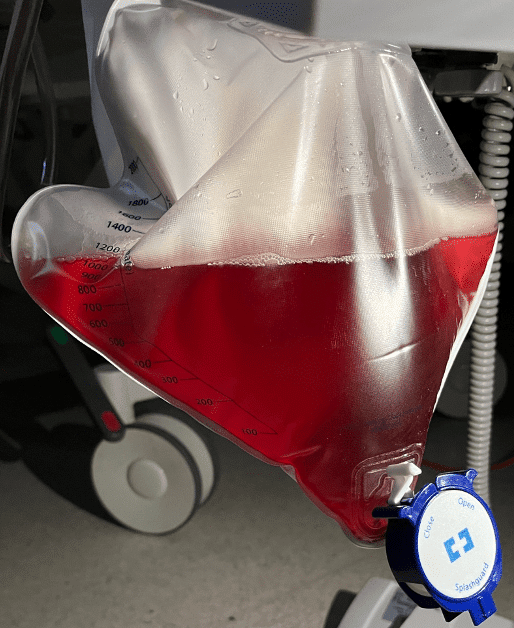Raspberry urine?
aka Unusual Urine 008 from Craig Johnston, INTENSIVE
On your nightshift, the bedside nurse asks you to review a 65-year-old female with red urine in her indwelling urinary catheter bag. She has just been admitted to ICU following a house fire where she was trapped and has been intubated after sustaining an inhalational injury.
There was no other traumatic injury sustained and a urine dip is negative for haemoglobin
Questions
Q1. What is the likely reason for her discoloured urine?
Unusual answer
Hydroxocobalamin has been administered.
A red discolouration to the skin and mucous membranes may also be noted in addition to the urine1,2.
Q2. Why was the agent (identified in Q1) administered?
Unusual answer
This patient had suspected cyanide toxicity.
The indications1,4 for hydroxocobalamin in suspected cyanide toxicity include:
- Altered mental status
- Seizures
- Hypotension
- Lactic acidosis
Q3. How does this underlying condition (identified in Q2) manifest clinically?
Unusual answer
Cyanide toxicity1,3 results from cyanide binding to the ferric ion (Fe3+) of cytochrome oxidase, inhibiting oxidative phosphorylation in mitochondria.
Early clinical features include
- Nausea and vomiting
- Headache
- Tachycardia and tachypnoea
- Agitation
- Seizures
Late clinical features include
- Hypotension and bradycardia
- Confusion
- Tetany
- Respiratory depression
- Coma
Investigations usually reveal
- hyperlactataemia and high anion gap acidosis.
- high venous O2 saturation, with a low arterial-venous oxygen difference (i.e. a low O2 extraction ratio as mitochrondria are unable to utilise oxygen).
Q4. What is the mechanism of action for the agent identified in Q1?
Unusual answer
Hydroxocobalamin is a vitamin B12 precursor1,4,5.
In high doses it chelates cyanide, forming cyanocobalamin which is non-toxic and excreted in urine
Aerobic metabolism can then resume normally.
Hydroxocobalamin is available as a “Cyanokit®” containing 2 vials of 2.5g hydroxocobalamin as a powder, and 2 vials of 100ml 0.9% NaCl for reconstitution.
To administer:
- Reconstitute one vial (2.5g) in 100ml of 0.9% NaCl, and give over 15 mins
- Repeat with the second vial
- This should be sufficient to bind 100mg of cyanide (but often quantity is unclear with inhalational injury)
- If patient is in cardiac arrest, give 5g as an IV push.
Note that this dose is huge in comparison to the dose given for Vitamin B12 deficiency (250 – 1000mcg per IM injection).
Hydroxocobalamin has a low side effect profile, in that if it is given to a patient without cyanide poisoning, there is low risk of an adverse outcome.
Q5. What commonly used ICU drug can also cause the underlying condition identified in Q2?
Unusual answer
Sodium nitroprusside.
SNP contains 5 cyanide groups and one nitric oxide group attached to a central iron molecule covalently bonded to Na.
When SNP reacts with oxyhaemoglobin in red blood cells, it releases nitric oxide (causing arterial and venous vasodilation and reducing MAP), and also 5 cyanide ions.
At high dose this can cause cyanide toxicity.
References
- Murray L, Little M, Pascu O, Hoggett K. Toxicology Handbook, 3rd Edition. Australia: Elsevier Australia; 2016
- Cescon D, Juurlink D. Discoloration of skin and urine after treatment with hydroxocobalamin for cyanide poisoning. CMAJ 2009; 180(2): 251
- Nickson CP. Cyanide Poisoning. LITFL CCC.
- Nickson CP. Hydroxocobalamin. LITFL.
- Therapeutic Goods Administration: Product and Consumer Information. Hydroxocobalamin. Accessed 23 Feb 2022.
- Chee-How E. What drug was given?! Twitter 2022
- Borron SW, Baud FJ, Barriot P, Imbert M, Bismuth C. Prospective study of hydroxocobalamin for acute cyanide poisoning in smoke inhalation. Ann Emerg Med. 2007 Jun;49(6):794-801
- Shepherd G, Velez LI. Role of hydroxocobalamin in acute cyanide poisoning. Ann Pharmacother. 2008 May;42(5):661-9
- Rogers J. Cherry red or Raspberry Urine. LITFL 2022
[cite]
Unusual Urine
Clinical cases
Chris is an Intensivist and ECMO specialist at The Alfred ICU, where he is Deputy Director (Education). He is a Clinical Adjunct Associate Professor at Monash University, the Lead for the Clinician Educator Incubator programme, and a CICM First Part Examiner.
He is an internationally recognised Clinician Educator with a passion for helping clinicians learn and for improving the clinical performance of individuals and collectives. He was one of the founders of the FOAM movement (Free Open-Access Medical education) has been recognised for his contributions to education with awards from ANZICS, ANZAHPE, and ACEM.
His one great achievement is being the father of three amazing children.
On Bluesky, he is @precordialthump.bsky.social and on the site that Elon has screwed up, he is @precordialthump.
| INTENSIVE | RAGE | Resuscitology | SMACC

